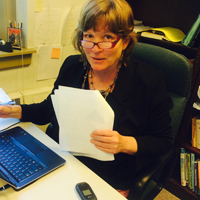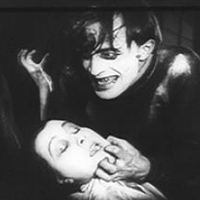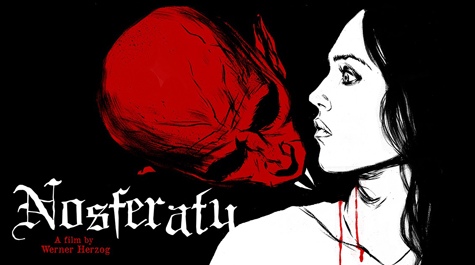Keep telling yourself, 'It's just a movie'
According to Jenny Taylor, there’s a tried-and-true recipe for creating a great “haunting” film, the kind you might be tempted to watch this spookiest week of the year, though not by yourself.
“Mostly, they have to take place in a domestic space, like a house, or the American farmhouse,” explained Taylor, associate professor of German studies at William & Mary, whose research and teaching interests include German film, especially German horror films such as the 1920 classic The Cabinet of Dr. Caligari.
{{youtube:medium|6lXUCyZkfBg, Taylor discusses the appeal of horror films.}}
“Usually a family has moved from the city to the country and they are so happy, and it’s a sunny day -- and you know they’re dead, or some of them are dead,” she continued. “They move into the house, something’s wrong with the house, as in (2013’s) The Conjuring. Or they don’t know that they have a basement. They find out and they go into the basement and the protagonist comes face to face with the monster who is always a double of the protagonist, something like Dr. Jekyll and Mr. Hyde.
“So you’ll have the protagonist with whom you identify and then you have the monster, with whom you don’t identify . . . You kill the monster, of course, because you have to – but you know he’s coming back. Freud called that the return of the repressed.”
Taylor points to F.W. Murnau’s German silent film Nosferatu, released in 1922 and an adaptation of Bram Stoker’s "Dracula," as an early example of a classic horror film where the protagonist and the monster are one and the same.
“The film might show the protagonist and the monster face to face, might show them moving in the same way; we might see the hero exposing his teeth, for example, as in Nosferatu,” she said. “The Jonathan Harker character is identified early as a double of the vampire, Nosferatu. So part of what’s scary in this convention is that you have to come face to face with the monster within you.”
More modern examples are Rouben Mamoulien’s Dr. Jekyll and Mr. Hyde (1931) and Stanley Kubrick’s The Shining (1980) the latter starring Jack Nicholson as a good, doting father and husband who becomes possessed by a supernatural presence and attempts to murder his family.
Films like The Texas Chainsaw Massacre (1974) or Friday the 13th (1980) or Alien (1979) are frightening. But they aren’t, in Taylor’s estimation, “haunting” or “horror” films.
Blood, she said, does not a horror or haunting film make.
“For me, the scariest films are the ones without much gore,” she explained. "The Shining is scariest when the camera gets up close behind the child and it’s all in light. It’s less scary (in the famous scene where) the blood is flowing out of the elevator. The ‘slasher films’ don’t affect me -- but they do affect some people.”
The study and analysis of horror films is not some hobby for Taylor. For a long time, she has taught a class at W&M on Weimar horror films and their influence on Hollywood. Weimar is the name given by historians to the federal republic established in 1919 in Germany to replace the imperial form of government. It is named after Weimar, the city where the constitutional assembly took place.
The class includes units on Dracula, Frankenstein and the werewolf, as well as well as a sci-fi unit because of the film Metropolis, which was made in 1927 by Fritz Lang and his wife, Thea von Harbou, and presented a dystopic view of the big city, based in part on New York.
She is also presently writing a book about “haunting” films that are in dialogue with older haunting films.
“The Conjuring from 2013 is scary as all get out,” she said. “… I’m writing about it and I think it’s really interesting read in dialogue with Roman Polanski’s 1968 version of Rosemary’s Baby about the abortion debates in the U.S. and how the debate has changed, because Rosemary’s Baby came out about the time of Rowe v Wade.”
Maybe the ultimate question is why do we like these films? Why do we like to be scared out of our wits? Taylor has a theory.
“You can think of theater in general, cinema in general, as a place where human beings like to sit in the dark and be confronted with anxieties, whether it’s a horror film or terror film or an action film,” she said. “These anxieties can be resolved. You sit in the dark, you have your popcorn, you identify with the protagonist, the bad guy usually loses – unless it’s a European film – and you go home with a sense of resolution.
“You might think of it, especially horror films, as a sort of mass therapy, where everybody projects their anxieties onto the screen and then you get to go home and sleep in your own bed. So it’s a place where it’s safe to confront these anxieties.”
To learn more about true classic haunting films, Taylor suggests watching Nosferatu, The Cabinet of Dr. Caligari, Dracula, starring Bela Lugosi, Frankenstein, the 1931 release, and Bride of Frankenstein and Dr. Jekyll and Mr. Hyde, also from 1931.
{{youtube:medium|iwk5cmZV04A, Taylor's top-10 horror films.}}
















